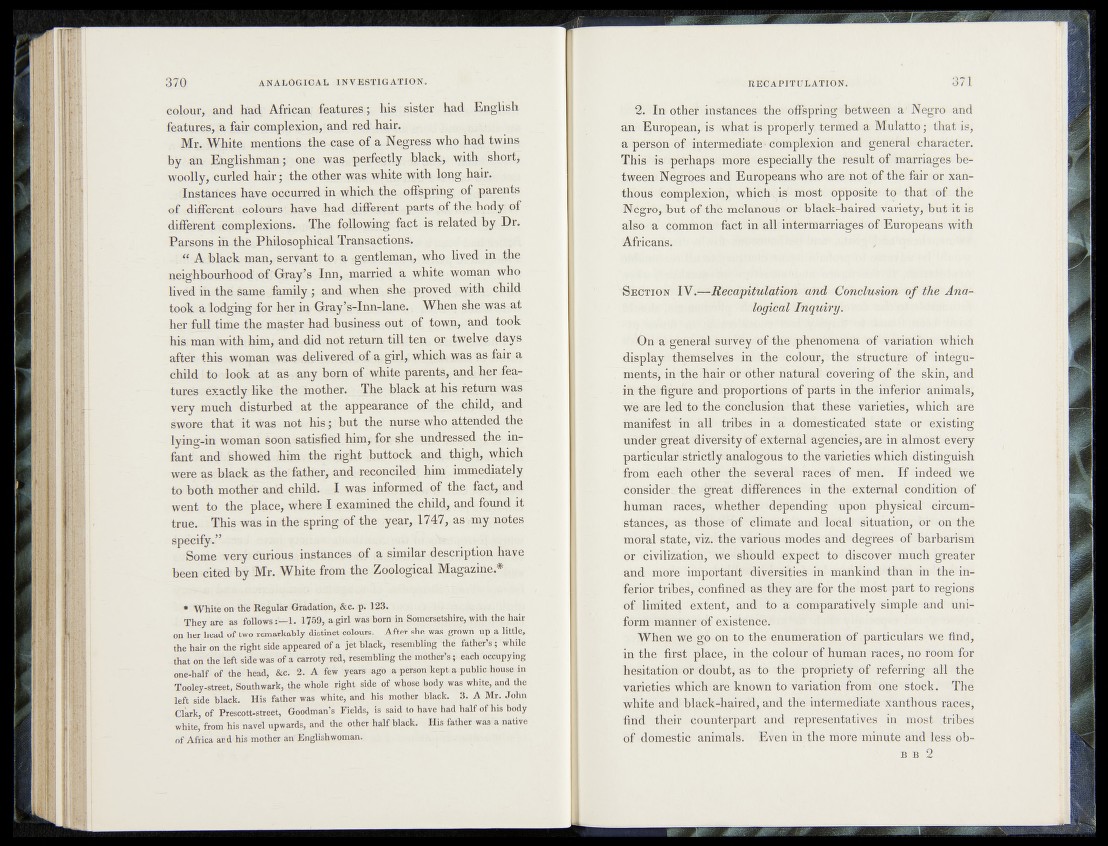
colour, and had African, features; his;sister had English
features, a fair complexion, and red hair.
Mr. White mentions the c^se of a Negress who had twins
by an Englishman; one-was-perfectly black, with short,
woolly, curled hair; the other was white with long hair.
'Instances have occurred in which the offspring of parents
of different colours have had different parts of the body of
different complexions. The following fact is related by Er.
Parsons in the Philosophical Transactions.
“ A black man, servant to a gentleman, who lived in., the
neighbourhood of'Gray’s Inn, married a white woman who
lived in the same family ; and when she . proved . with child
took a lodging for her in Gray’s-Inn-lane. When she was at
her full-time the master had.business- ou ti:of town, and took
his. man with him, and did not return till ten or twelve days
after this woman was delivered o f .a gir},, wfeefeyas as ^ah a
child to look at as any born of white parenfex;and her features
exactly like the mother. The black at his return was
very much disturbed at the appearance of th,e -child,""and
swore that it was not his $1 but the nurse who attended the
lying-in woman soon satisfied him, -for she undressed fh,e infant
and showed him the right buttock and .thigh, whicb
were as black as the father, and reconciled him immediately
to both mother and child. I was informed | of the, fec^-and
went to the place, where I examined the child, and found it
true. This was in the spring of the -year, 1747, astmy nptes
specify^fyaa
Some very curious instances of a similar description have
been cited by Mr. White from the Zoological Magazine.*
* White on the Regular Gradation, &c. p. 123.
They are as follows :— l . 1759, a girl was bom in Somersetshire, with the hair
on her head of two remarkably distinct colours. After she was grown up a little,
the hair on the right side appeared of a jet black, resembling the father’s ; while
that on the left side was of a carroty red, resembling the mother’s ; each occupying
one-half of the head, &c. 2. A few years ago a person kept a public house in
Tooley-street, Southwark, the whole right side of whose body was white, and the
left side black. His father was white, and his mother black. 3. A Mr. John
Clark, of Prescott-street, Goodman’s Fields, is said to have had half of his body
white, from his navel upwards, and the other half black. His father was a native
ofAftica and his mother an' Englishwoman.
jjfgjPPIp other instances the offspring between a Negro and
am European,! is what is properly termed a Mulatto; that is,
a person of intermediate -complexion and general character.
This -is pteVhaps.more especially the result of marriages between
Negroes- and.Europeans who are not of the fair or xanthous
complexion, which^is! most opposite to that of the
NegF©f4)ut of the melanous or black-haired variety, but it is
also a common; fact in all intermarriages of Europeans with
Africans. BH HHNH ffifil jJP
S e c t io n IV.—-Recapitulation and Conclusion o f the Ana-
Ü logical Inquiry.
' > On a general survey of the,phenomena of variation which
display" themselves in the ■'colour, the structure of integuments,
in the.hair dr other natural covering of the skin, and
in the figure and proportions of parts in the inferior animals,
we are led to the conclusion ' tha t these varieties, which are
manifest inwall “ tribes-in a domesticated Estate Or existing
under’ great diversity ©^external agencies, are in almost every
particular ,strictly analogous to the varieties which distinguish
from each other the several races! of menJ!' If indeed" y e
consideh/the g-reat differences in the external condition of
human racés, - whether depending upon physical circumstances,’
as those tsf climate and'foCal situation, or on the
moral state, viz.-the various modes and degrees• of' barbarisni
o r^ iii^ liz a tfeh ^ ^ ^ ^oM d expect to discover much greater
and more important diversities in mankind than in the inferior
tribes, confine as they are for the j most part to regions
of limited extent, and tfe a comparatively •simple and uniform
manner of existence;*'"
When w© gpon to the -enumeration d f , particulars, we find,
in the first place, in the colour of human races, no room; for
hesitation or doubt, as to the; propriety of rèferring^-all the
varieties which'are known to variation from one'1 stock i The
white and’ black-haired, and the intermediate xanthous'races,
find their Counterpart and representatives in' most tribes
Of domestic animals. Even in the more minute and less ob